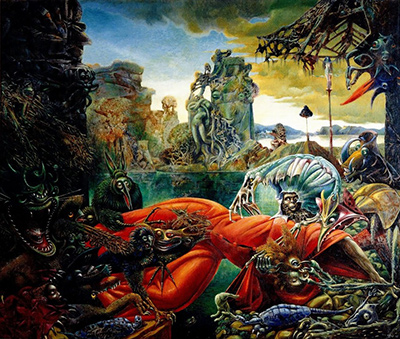The Temptation of Saint Anthony, a 1945 oil on canvas painting, was executed by Max Ernst. Carrington, Ernst, Dali and other modern artists participated in a contest to find out who would create the most interesting interpretation to be used in a film.
All the artist who took part in the competition received 500 dollars, while the winner was given a prize of 3000 dollars. Ernst won this contest and his painting was displayed in the film. This occurred towards the end of World War II, and this global war produced and altered interesting imagery in the artist's work.
Description of the Painting
The painting is an impressive version of a biblical tale. It depicts Anthony the Great, the desert father, as demons are tormenting him in Egypt. The desert father is wrapped in red cloths and demonic creatures are parading him around. These are all mucking around in a strange setting that looks like a swampy pond that has a bizarre stone formation. Line theory is present in this painting. There are lots of horizontal lines describing the passive pond in the background. The diagonal lines of fingers of these creatures and the creases in the sheet pointing to Saint Anthony break this serenity.
Colour theory is also clear in this painting. The deep hue of the cloths St Anthony is wearing helps in pointing him out and setting him aside from the dark creatures tormenting him. According to the colour wheel, red is the opposite colour of green. In the background, the rocks and the water are sickly green. Additionally, the skin highlights of Anthony's face, as well as the birdlike humanoid beasts around him, have a minty yellow tone on their arms that contrasts with the bright red. The dark creatures on the left side of the painting are set apart as well. While they are dark green in colour, they have fur on their body, unlike the other creatures. This texture set these creatures apart, drawing the viewer's eyes to them.
Craftsmanship
The painting has a high grade of detail. Although it uses surrealism, all the creatures and fantastical forms depicted, along with the rock formation, trees and water reflections, have an impressive amount of skill. The most notable elements of this painting are the creatures. They have a high level of detail; their imitation of teeth, claws and fur give them a gritty, evil look. Each creature has a different personality and facet, and their distinct expressions show how much time the artist spent on this painting.




